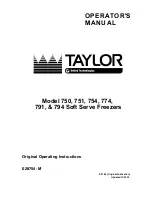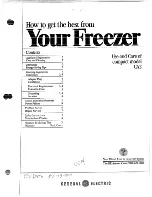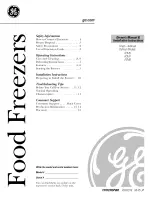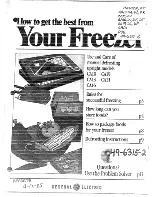
13
12
CLEANING AND CARE
** We recommend that you switch off the freezer at the socket outlet and pull out
the mains plug before cleaning.
** Never use any sharp abrasive instrument, soap, household cleaner, detergent
and wax polish for cleaning.
** Use luke warm water to clean the cabinet of the freezer and wipe it dry.
** Use a damp cloth wrung out in a solution of one teaspoon of bicarbonate of
soda to one pint of water to clean the interior and wipe it dry.
** Excess deposit of ice should be removed on a regular basis using the handle of
a spoon. Large accumulation of ice will impair the performance of the
freezer.
** If the freezer is not going to be used for a long period of time switch it off,
remove all food, clean it and leave the door ajar.
** To remove a drawer, pull it as far as possible, and then tilt it upwards, and
then pull it out completely.
** Any dust that gathers on the condenser, which is located at the back of the
freezer, should be removed once a year with a vacuum cleaner.
** Check door seals regularly to ensure they are clean and free from food
particles.
** Never :
• Clean the worktop with unsuitable material; eg petroleum based products.
• Subject it to hot temperatures in any way,
• Scour, rub etc., with abrasive material.
** Take care when installing your appliance and using it for the first time, during
normal daily use, while defrosting and cleaning the interior freezer compartments
not to damage cold panels and pipes and to avoid any injury. We recommend
the use of a pair of gloves when cleaning the cold panels as you might injure
your fingers and hands and/or damage the appliance beyond repair.
DO'S AND DON'TS
Do- Check contents of the freezer at regular intervals.
Do- Clean and defrost your freezer regularly (See "Defrosting")
Do- Keep food for as short a time as possible and adhere to "Best Before",
"Use By" dates.
Do- Store commercially frozen food in accordance with the instructions given
on the packets that you buy.
Do- Always choose high quality fresh food and be sure it is thoroughly clean
before you freeze it.
Do- Prepare fresh food for freezing in small portions to ensure rapid freezing.
Do- Wrap all foods in aluminium foil or freezer quality polythene bags and
make sure any air is excluded.
Do- Wrap frozen food when you buy it and put it in to the freezer as soon as
possible.
Do- Separate food in the compartments. This will enable you to find food quickly
and avoid excessive door opening therefore save electricity.
Do- Remove ice cream from the freezer 10-20 minutes before serving.
Don't- Leave the door open for long periods as this will make the freezer more
costly to run and cause excessive ice formation.
Don't- Use pointed sharp edged objeects such as knives, forks to remove the ice.
Don't- Put hot food into the freezer. Let it cool down first.
Don't- Put liquid-filled bottles or sealed cans containing carbonated liquids into
the freezer as they may burst.
Don't- Store poisonous or dangerous substances in the Freezer. Your freezer has
been designed for the storage of edible foodstuffs only.
Don't- Exceed the maximum freezing capacity (10.5 kg in any 24 hours) when
freezing fresh food.
Don't- Consume ice-cream and water ices direct from the freezer. The low
temperature may cause 'freezer burns' on lips.
Don't- Freeze fizzy drinks.
Don't- Try to keep frozen food which has thawed, it should be eaten within 24
hours or cooked and refrozen.
Don't- Remove items from the freezer with wet hands.
Don't- Close the door before placing the fast-freeze compartment cover in its
place.
Don’t- L
eave frozen food at room temperature to thaw; the best way to defrost
food is to put it in the fridge to thaw slowly. Make sure you avoid defrosting
food or food juices drip onto other food.
PROBLEM SOLVING
If the appliance does not operate when switched on, check:
• The plug is inserted properly in the socket and that the power supply is on. (To
check the power supply to the socket, plug in another appliance)
• The fuse has blown/circuit breaker has tripped/main distribution switch has
been turned off.
• The temperature control has been set correctly.
• New plug is wired correctly if you have changed the fitted moulded plug.
If the appliance is still not operating after the above checks, please refer to the
section on “How To Obtain Service”.
Please ensure that above checks have been made as a charge will be made if no
fault is found.



























